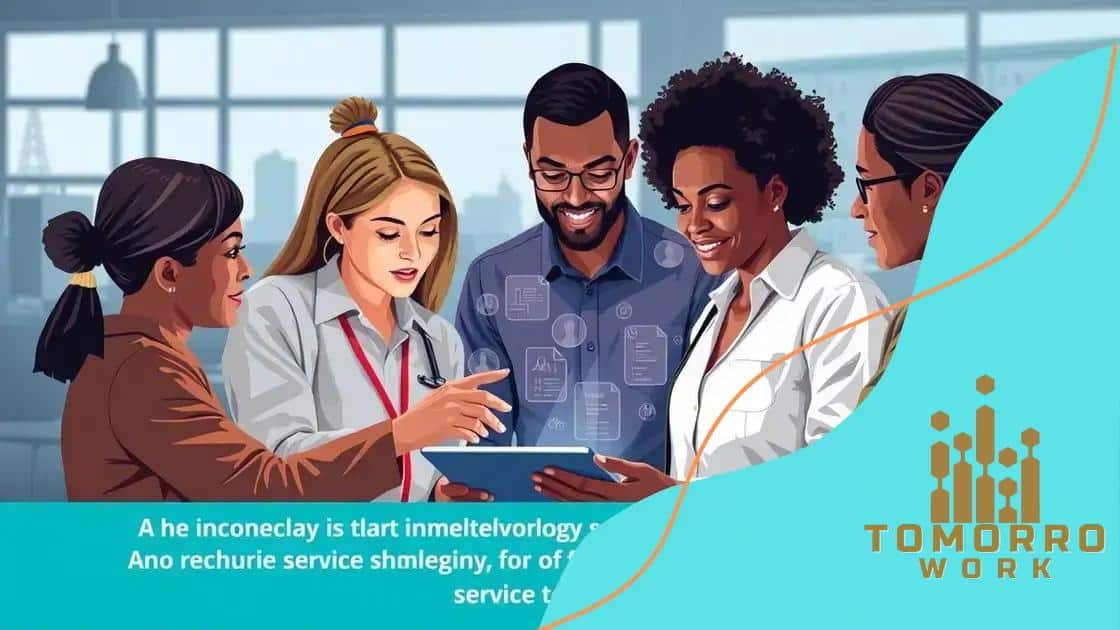How digital tools are improving public benefits applications

Advertisements
Digital tools are significantly improving public benefits applications by enhancing efficiency, user accessibility, and satisfaction through streamlined processes and real-time updates.
Digital tools are transforming the way we approach public benefits applications. By using technology, we can make these processes smoother and more accessible, enhancing the overall experience for users. Curious about how this works? Let’s dive in!
Advertisements
The role of technology in public services
The role of technology in public services is crucial in delivering essential benefits to those in need. With advancements in digital tools, applicants can now access information and services more easily than ever before. This shift not only makes the application process more efficient but also enhances customer satisfaction.
Impact of Technology on Public Services
Technology has revolutionized how public services operate by enabling online applications and streamlining workflows. This means people can submit applications from their homes without the need for long queues at agencies. Moreover, real-time updates keep applicants informed about their application status, providing peace of mind.
Key Benefits Include:
- Improved Accessibility: Services are available 24/7, making it easier for users to find help when they need it.
- Faster Processing Times: Automated systems reduce the time taken to process applications.
- Enhanced Communication: Applicants can receive immediate notifications regarding their applications.
By leveraging data analytics, public agencies can identify trends and needs within communities. This allows for a more targeted approach to service delivery, ensuring that resources are focused where they are most needed.
Advertisements
Furthermore, technology aids in detecting fraud, protecting public funds. With better security systems in place, agencies can safeguard sensitive information and build trust with the public.
Overall, the continuous integration of technology in public services will lead to a more responsive and user-friendly experience. As societal needs evolve, so will the technology that supports these critical services.
Benefits of digital tools for applicants
The benefits of digital tools for applicants are significant and impact how individuals access public services. These tools simplify complex processes, allowing users to navigate applications with ease. Additionally, they provide greater flexibility, as people can apply for benefits from anywhere and at any time.
Key Advantages of Using Digital Tools
One major benefit is the speed at which applications are processed. Digital submissions reduce the time spent compared to traditional paper methods. Users can also track their application progress online, which reduces anxiety and uncertainty during the waiting period.
Some important benefits include:
- Increased Efficiency: Tasks that once required multiple steps can now be completed in a few clicks.
- Cost Savings: Both applicants and agencies save money on printing and mailing costs.
- Personalized Assistance: Many platforms offer chatbots or online support to guide users through the process.
Moreover, digital tools can assist applicants with disabilities by providing accessibility features that cater to their specific needs. For example, screen readers or translation services can enhance usability. Knowing that help is readily available can empower users to complete applications successfully.
As technology continues to advance, we can expect even more benefits to emerge. Innovations like artificial intelligence and machine learning can provide tailored recommendations for users based on their profiles. This personalized approach can lead to better outcomes and satisfaction.
Challenges in implementing digital solutions

Implementing digital solutions in public services comes with several challenges. While technology offers numerous benefits, the transition from traditional methods can be complicated. Both agencies and users must adapt to new processes and systems, which can create resistance.
Common Challenges Faced
One of the most significant barriers is the digital divide, where some individuals lack access to technology or the internet. This creates disparities in who can benefit from digital public services. Additionally, many people may not know how to navigate new digital platforms, leading to frustration.
Other challenges include:
- Security Concerns: Protecting sensitive information is crucial as more users engage with digital systems.
- Cost of Implementation: Upgrading existing infrastructure and training staff can be expensive for public agencies.
- Change Management: Staff resistance to adopting new technologies can hinder progress and efficiency.
Moreover, ensuring that digital tools are user-friendly can be a challenge. If platforms are complex, users may abandon applications altogether. Agencies must prioritize accessibility and usability to make sure everyone can benefit from these digital advancements.
Lastly, keeping pace with technological advancements requires ongoing investment and training. Agencies must stay informed about new trends to ensure they provide the best possible services. Regular updates and user feedback are essential for continuous improvement.
Success stories of improved applications
Success stories of improved applications highlight the positive impact of digital solutions in public services. These examples showcase how technology can transform user experiences and streamline processes. By examining these cases, we can understand the potential benefits of digital tools.
Real-World Examples
One notable success is an online platform created for food assistance applications. This platform reduced processing times dramatically, allowing families to receive support within days instead of weeks. Users praised the ease of navigating the digital forms and appreciated the real-time updates on their application status.
Key Highlights Include:
- User Satisfaction: Many users reported feeling more empowered by being able to manage their applications online.
- Faster Service Delivery: Agencies saw a decrease in the backlog of applications, which helped serve the community better.
- Higher Engagement: More residents began using public services due to the convenience of online access.
Another inspiring story comes from a state that implemented a digital case management system. This system improved collaboration among various departments, ensuring that every application received the attention it needed. Staff members reported feeling less overwhelmed and more productive.
With better communication tools, agencies were able to track applications more effectively and reduce errors. This improvement not only reassured applicants but also enhanced overall trust in public services.
These success stories demonstrate that embracing technology can lead to significant improvements in how public benefits are accessed. As more agencies adopt innovative practices, we can expect to see even more positive outcomes.
Future trends in digital public services
Future trends in digital public services indicate an exciting path toward innovation and improvement. As technology advances, public services will likely become more integrated, user-friendly, and personalized. These changes promise to enhance access and efficiency for all users.
Emerging Technologies
Artificial intelligence and machine learning are set to play significant roles in shaping digital public services. These technologies can help analyze data to identify patterns and trends, allowing agencies to allocate resources better. For example, predictive analytics can anticipate service demands, ensuring that help is available when needed.
Key Trends to Watch:
- Increased Automation: Processes will become more automated, reducing wait times and handling applications faster.
- Enhanced User Experience: Platforms will focus on being intuitive and accessible, making it easier for users to find the information and services they need.
- Mobile-First Approaches: More services will be optimized for mobile devices, recognizing that many users access online services via smartphones.
Moreover, digital inclusion will be a priority. Efforts will be made to ensure that everyone, regardless of their background or technological skill, can access essential services. This includes offering training sessions and support for those who need assistance navigating digital platforms.
Blockchain technology may also emerge in public services, providing a secure way to handle transactions and personal data. This transparency can build trust between agencies and the public, as users feel more secure about how their information is managed.
FAQ – Frequently Asked Questions about Digital Tools in Public Services
What are some benefits of using digital tools for public services?
Digital tools streamline applications, reduce processing times, and improve accessibility for users, making public services more efficient.
How can technology help overcome challenges in public services?
By implementing user-friendly platforms and offering support, technology can address barriers like the digital divide and improve user experiences.
What role does artificial intelligence play in digital public services?
Artificial intelligence aids in analyzing data, predicting service demands, and personalizing experiences for users, enhancing overall service delivery.
Are there success stories related to the adoption of digital tools in public services?
Yes, many agencies report faster processing times and higher user satisfaction due to efficient online platforms for public benefits.





